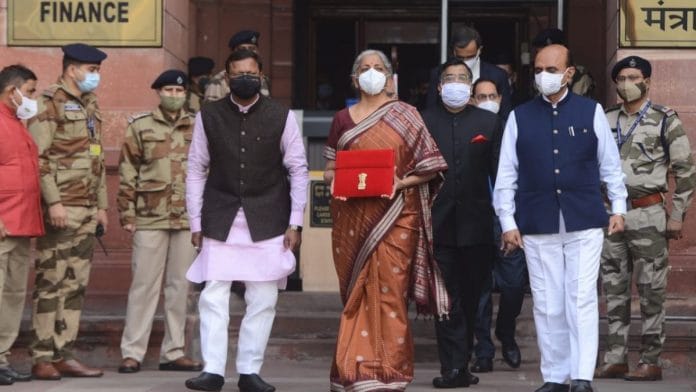New Delhi: Finance Minister Nirmala Sitharaman’s Budget 2022-23 has laid sole emphasis on providing impetus to growth through higher capital spending while shying away from any major changes in the income tax.
With a focus on sustaining the current fiscal’s growth momentum, FM Sitharaman has sharply increased allocation for capital spending to Rs 7.5 lakh crore in 2022-23, up 35.4 per cent from the budget estimates in 2021-22.
In the total outlay for FY23, the government will spend Rs 39.45 lakh crore, an increase of 4.6 per cent from the revised spending target of FY22 at Rs 37.7 lakh crore.
“At this stage, private investments seem to require that support to rise to their potential and to the needs of the economy. Public investment must continue to take the lead and pump-prime the private investment and demand in 2022-23,” FM Sitharaman said in her speech.
With this, the government also pegged the fiscal deficit — gap between revenue and spending where the latter is higher — for FY23 at 6.4 per cent of the GDP, reflecting the focus on spending for creating more capital in the economy. The fiscal deficit for FY22 has been marginally revised upwards to 6.9 per cent.
To finance this deficit, the government will borrow Rs 14.95 lakh crore on a gross basis from the bond market and rest will be financed by proceeds of small savings and loans from multilateral agencies like the World Bank.
However, the Modi government has been conservative in its growth targets. In absolute terms or nominal GDP, India is expected to grow at 11.1 per cent at Rs 258 lakh crore in FY23.
The Economic Survey presented Monday estimated India’s real GDP to grow at 8-8.5 per cent in the next financial year, which would translate to a higher nominal GDP growth, when adding for an average retail inflation at 5 per cent.
In the first advance estimates for FY22 released on 7 January, the government had estimated the nominal GDP to grow by 17.6 per cent at Rs 232.15 lakh crore.
Seven engines to drive growth
Listing roads, railways, airports, ports, mass transport, waterways and logistics infrastructure as the key areas of focus in the budget, FM Sitharaman said: “The budget’s approach is driven by seven engines”.
All seven engines will “pull forward the economy in unison” complemented by energy transmission, water and sewerage sector and social infrastructure, she said.
However, the Modi government has slashed the allocation for Mahatma Gandhi National Rural Employment Guarantee Scheme to Rs 73,000 crore in 2022-23, down from the revised Rs 98,000 crore it will spend on the scheme in 2021-22.
The subsidy burden, too, has come down for the government by 26.5 per cent to Rs 3.18 lakh crore in FY23. The government had spent Rs 4.33 lakh crore on providing major subsidies in FY22. The major subsidies include those on food, fertiliser and petroleum products like kerosene.
Also Read: No changes in tax slabs, deductions — FM Sitharaman gives middle class a skip in Budget 2022
Conservative tax targets
The Budget has projected the Modi government’s gross tax collections in 2022-23 at Rs 27.58 lakh crore, up 9.6 per cent from the revised estimate for the ongoing fiscal.
The government also raised the tax collection estimate for 2021-22 to Rs 25.16 lakh crore, from Rs 22.17 lakh crore projected initially on the back of buoyancy this fiscal because of a low base after a nationwide lockdown in 2020-21 to curb the spread of Covid-19 pandemic hit economic activity.
According to data from the Controller General of Accounts, the government’s gross tax collection grew to Rs 19.29 lakh crore in the April-December period, up 44.2 per cent from the year-ago period. The bulk of taxes come in the last quarter.
The revised estimate for tax collections of FY22 shows that there was not much effect on the revenues even after the Centre cut the excise duty on petrol and diesel by Rs 5 per litre and Rs 10 per litre, respectively, in November.
The government now estimates excise duty collections in FY22 at Rs 3.94 lakh crore, up Rs 59,000 crore from the budget estimate of Rs 3.35 lakh crore.
The excise duty collections, however, in 2022-23 are estimated to fall 15 per cent, due to the full-year impact of the cut in excise duty on petrol and diesel.
The government has also reduced its reliance on disinvestment to meet fiscal targets. It has set a disinvestment target of Rs 65,000 crore for 2022-23, against the revised estimate of Rs 78,000 crore in FY22.
In Budget 2021-22, the government had set an ambitious disinvestment target of Rs 1.75 lakh crore. However, with big ticket privatisation of Bharat Petroleum Corp Ltd unlikely to be concluded in the current fiscal, the estimate has sharply revised downwards.
The Budget also didn’t bring much cheer for the middle class as FM Sitharaman shied away from announcing any changes in the income tax slabs or deductions.
(Edited by Amit Upadhyaya)






